
ENSINO DA DEFORMAÇÃO DAS ROCHAS: CONTRIBUTOS DAS ATIVIDADES PRÁTICAS
Introdução e Objetivo: Este artigo descreve um conjunto de atividades práticas sobre deformação das rochas. Trabalhos práticos são atividades de ensino e aprendizagem em ciências que incluem as demonstrações em sala de aula feitas pelo professor e as atividades dos alunos em laboratório ou em experimentos. Metodologia: Para atingir aprendizagem profunda ou significativa e a correspondente aquisição de competências, deve haver formulação precisa dos conteúdos e objetivos educacionais que os alunos devam atingir. Resultado: As estratégias de experimentação compreendem atividades confirmatórias, de questionamento, atividades por redescoberta, e atividades baseadas em resolução de problemas. Em função dos objectivos exigidos, o material didático empregado deve ter estrutura simples, ser de fácil obtenção e capaz de facilitar ao aluno a compreensão do fenómeno estudado. Deve ajustar-se às caraterísticas psicológicas dos alunos e à profundidade com que se estudam as matérias. Conclusão: Os exemplos reunidos atendem ao requisito de custo reduzido, para superar as limitações económicas das escolas, contribuir para a educação social, no seu aspeto ético-económico, bem como despertar o interesse dos estudantes e da comunidade.
ENSINO DA DEFORMAÇÃO DAS ROCHAS: CONTRIBUTOS DAS ATIVIDADES PRÁTICAS
-
DOI: 10.37572/EdArt_2805238045
-
Palavras-chave: Geologia, Geociências, Inovação, Educação Básica, Materiais Didáticos.
-
Keywords: Geology, Geosciences, Innovation, Basic Education, Teaching Materials.
-
Abstract:
Introduction and objective: this article describes a set of practical activities on rock deformation. Hands-on assignments are science teaching and learning activities that include both classroom demonstrations by the teacher and student activities in the laboratory or making practical experiments. Methodology: in order to achieve deep or meaningful learning and the corresponding acquisition of competences, the educational contents and objectives must be precisely presented to the students. Results: experimentation strategies include confirmatory activities, questioning activities, rediscovery activities, and problem-based activities. The didactic material used must have a simple structure, easy to obtain and capable of facilitating the student's understanding of the studied phenomenon. Depending on the required objectives, it must adjust to the psychological characteristics of the students and the depth with which the subjects are studied. Conclusion: the examples gathered meet the low-cost requirement, to overcome the economic limitations of schools, contribute to social education,
in its ethical-economic aspect, as well as awaken the interest of students and the community. -
Número de páginas: 40
- Jorge Bonito
- Hugo Oliveira
- Celso Dal Ré Carneiro

